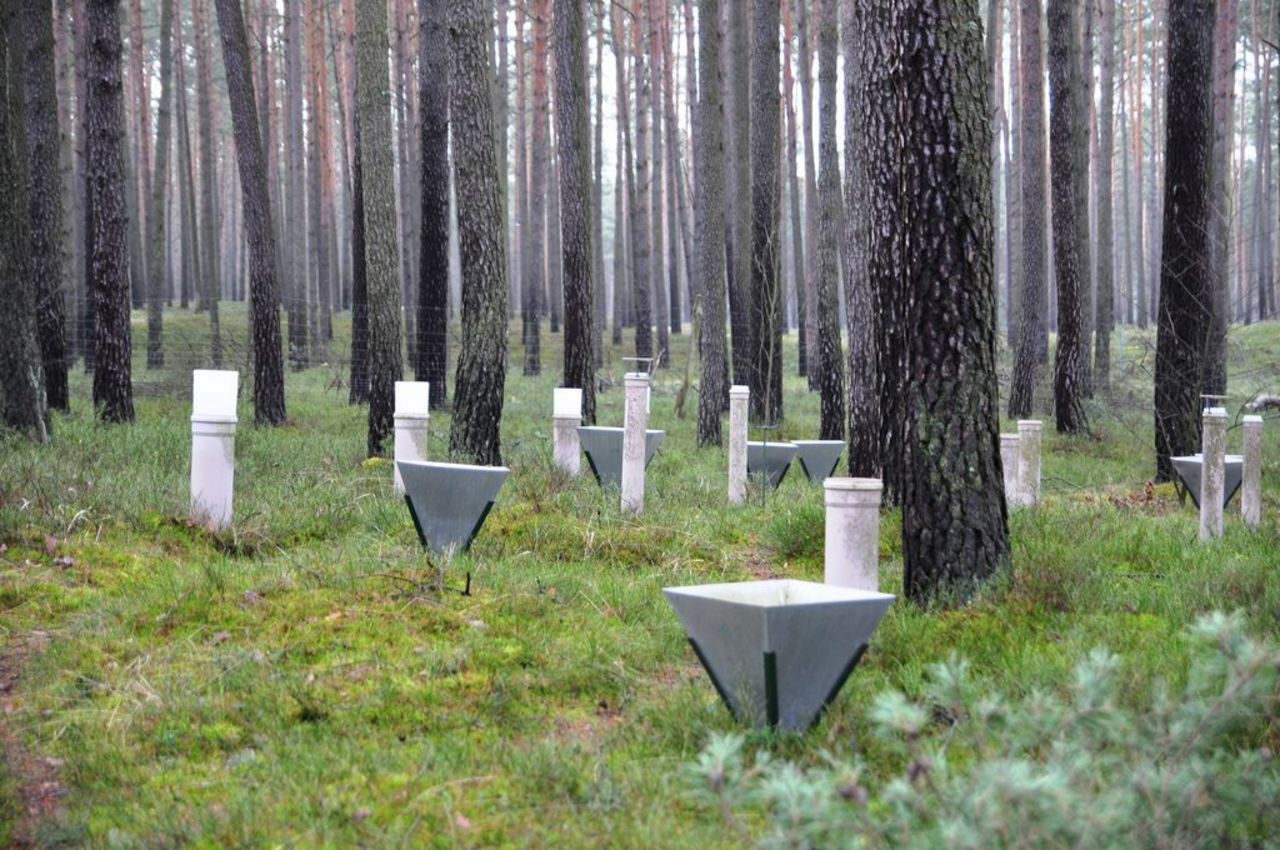Project
Level II

Intensive Forest Monitoring - Level II
The Intensive Forest Monitoring (Level II) is performed within selected forest sites (case studies). Data on relevant parameters is collected periodically or even continuously in order to describe status and development of forest ecosystems.
Background and Objective
The Level II monitoring is complementing the area-representative Level I monitoring (Crown condition assessment (WZE) and Soil survey (BZE)). It is part of the International Co-operative Programme on the Assessment of Air Pollution Effects on Forests (ICP Forests) under the umbrella of the Convention on Long-range Transboundary Air Pollution (CLRTAP). Established since the 1990s the permanent plots hold a variety of equipment to perform ecosystem-related studies on cause-effect relationships. In Germany data is collected on 68 sites for in total 14 surveys, partly in high temporal resolution. Data is quality checked, and fed into a data base at the PCC of ICP Forests. These activities performed by the German federal states are covered by a federal regulation based on the federal forest law since 01/01/2014. The collected data are internally evaluated and provided for national and international studies. At the moment in- and output studies of forest ecosystems are performed. Standard evaluation routines are developed as well.
Approach
The German federal states collect the data according to a internationally homogenised manual within the following surveys: crown condition, increment, foliar element concentrations, litterfall, phenology, visible ozon injuries, ground vegetation, deposition, meteorology, soil solution and soil solid phase. Quality checks are also perfomed after the manual. Gap replacement as well as the application of canopy flux models are applied according to adequate process-related models. Inference statistics are for crown condition, increment, foliar element concentrations or ground vegetation as response variables and deposition, soil, climate-related variables, or soil parameters as drivers are performed at different temporal and spatial scales.
Thünen-Contact

Involved Thünen-Partners
Duration
Permanent task 1.1995
More Information
Project status:
ongoing
Contact
[Translate to English:] http://blumwald.thuenen.de/level-ii/allgemeine-informationen/ansprechpartner/
Publications
- 0
Ferretti M, Gessler A, Cools N, Fleck S, Guerrieri R, Jakovljevic T, Nicolas M, Nieminen TM, Pitar D, Potocic N, Raspe S, Schaub M, Schwärzel K, Timmermann V, Vejpustková M, Vesterdal L, Vanninen P, Waldner P, Zimmermann L, Sanders TGM (2024) Resilient forests need joint forces for better inventorying and monitoring. Forest Ecol Manag 561:121875, DOI:10.1016/j.foreco.2024.121875
- 1
Rukh S, Sanders TGM, Krüger I, Schad T, Bolte A (2023) Distinct responses of European beech (Fagus sylvatica L.) to drought intensity and length - A review of the impacts of the 2003 and 2018-2019 drought events in Central Europe. Forests 14(2):248, DOI:10.3390/f14020248
- 2
Schmitz A, Sanders TGM, Bolte A, Bussotti F, Dirnböck T, Penuelas J, Pollastrini M, Prescher A-K, Sardans J, Verstraeten A, de Vries W (2023) Responses of forest ecosystems in Europe to decreasing nitrogen deposition. In: Du E, de Vries W (eds) Atmospheric nitrogen deposition to global forests : Spatial variation, impacts, and management implications. London: Academic Press, pp 227-245
- 3
Rukh S, Schad T, Strer M, Natkhin M, Krüger I, Raspe S, Eickenscheidt N, Hentschel R, Hölscher A, Reiter P, Sanders TGM (2022) Interpolated daily temperature and precipitation data for Level II ICP Forests plots in Germany. Ann Forest Sci 79:47, DOI:10.1186/s13595-022-01167-3
- 4
George J-P, Bürkner P-C, Sanders TGM, Neumann M, Cammalleri C, Voigt JV, Lang M (2022) Long-term forest monitoring reveals constant mortality rise in European forests. Plant Biol 24(7):1108-1119, DOI:10.1111/plb.13469
- 5
Krüger I, Schmitz A, Sanders TGM (2021) Climate condition affects foliar nutrition in main European tree species. Ecol Indic 130:108052, DOI:10.1016/j.ecolind.2021.108052
- 6
Wang S, Zhang Y, Ju W, Chen JM, Cescatti A, Sardans J, Janssens IA, Wu M, Berry JA, Campbell E, Fernandez-Martinez M, Alkama R, Sitch S, Smith WK, Yuan W, He W, Lombardozzi D, Kautz M, Sanders TGM, Krüger I, et al (2021) Response to Comments on "Recent global decline of CO2 fertilization effects on vegetation photosynthesis". Science 373(6562):1-8, DOI:10.1126/science.abg7484
- 7
Krüger I, Sanders TGM, Holzhausen M, Schad T, Schmitz A, Strich S (2020) Am Puls des Waldes : Umweltwandel und seine Folgen - ausgewählte Ergebnisse des intensiven forstlichen Umweltmonitorings. Berlin: BMEL, 51 p
- 8
Sanders TGM, Krüger I, Holzhausen M (2020) Das intensive forstliche Monitoring - Level II. Eberswalde: Thünen-Institut für Waldökosysteme, 2 p, Project Brief Thünen Inst 2020/25, DOI:10.3220/PB1608106763000
- 9
Sanders TGM, Spathelf P, Bolte A (2019) The response of forest trees to abiotic stress. Burleigh Dodds Ser Agric Sci 71:99-116, DOI:10.19103/AS.2019.0057.05
- 10
Krause S, Strer M, Mund J-P, Sanders TGM (2019) UAV remote sensing data handling: A transition from testing to long-term data acquisition for intensive forest monitoring. J Photogramm Remote Sensing Geoinf Sci 28(39):167-174
- 11
Prescher A-K, Schmitz A, Sanders TGM, Nussbaumer A, Karlsson GP, Neirynck J, Gottardini E, Hansen K, Johnson J, Nieminen TM, Schaub M, Ukonmaanaho L, Vanguelova EI, Verstraeten A, Waldner P (2018) Change in sulphur pools in forest ecosystems following the reduction of atmospheric sulphur dioxide. Geophys Res Abstr 20:9027
- 12
Seidling W, Travaglini D, Meyer P, Waldner P, Fischer R, Granke O, Chirici G, Corona P (2014) Dead wood and stand structure - relationships for forest plots across Europe. iForest 7: 269-281, DOI:10.3832/ifor1057-007
- 13
Giordani P, Calatayud V, Stofer S, Seidling W, Granke O, Fischer R (2014) Detecting the nitrogen critical loads on European forests by means of epiphytic lichens : a signal-to-noise evaluation. Forest Ecol Manag 311(1):29-40, DOI:10.1016/j.foreco.2013.05.048
- 14
Seidling W, Kanold A, Kompa T, Lambertz B, Scheibe O, Schiller M, Schmiedinger A, Wenzel A, Werner W, Zoldan JW (2014) Vegetationserhebungen: Bearbeiterunterschiede bei Artenzahlen von Gefäßpflanzen. Tuexenia 34:329-346
- 15
Sanders TGM, Seidling W (2013) Damaging agents in different forest types for adapted risk management. In: Building bridges in ecology : linking systems, scales and disciplines ; GfÖ 43rd Annual Meeting of the Ecological Society of Germany, Austria and Switzerland ; September 9 to 13, 2013, Potsdam, Germany ; book of abstracts. Göttingen: Gesellschaft für Ökologie, pp 128-129
- 16
Seidling W, Ziche D, Beck W (2012) Climate responses and interrelations of stem increment and crown transparency in Norway spruce, Scots pine, and common beech. Forest Ecol Manag 284:196-204, DOI:10.1016/j.foreco.2012.07.015
- 17
Ziche D, Seidling W (2010) Homogenisation of climate time series from ICP forests level II monitoring sites in Germany based on interpolated climate data. Ann Forest Sci 67(8):804/1-804/6, DOI:10.1051/forest/2010051
- 18
Ziche D, Seidling W (2010) Homogenisierte Klimadaten aus dem Waldmonitoring . AFZ Der Wald 65(24):11-13
- 19
Cox F, Barsoum N, Lilleskov EA, Bidartondo MI, Seidling W (2010) Mykorrhizierung von Kiefernwurzeln : Stickstoffverfügbarkeit als Einflussfaktor. AFZ Der Wald 65(24):8-10
- 20
Ziche D, Seidling W (2009) Benefits of meteorological measurements at forest monitoring sites compared with interpolated climatic data. In: Kaennel Dobbertin M (ed) Long-term ecosystem research: Understanding the present to shape the future : International Conference, Zurich, Switzerland, September 7-10, 2009 ; Abstracts. p 28
- 21
Seidling W, Beck W, Ziche D (2009) Crown condition and radial stem wood increment: documentation of complex relationships. In: Kaennel Dobbertin M (ed) Long-term ecosystem research: Understanding the present to shape the future : International Conference, Zurich, Switzerland, September 7-10, 2009 ; Abstracts. p 95
- 22
Seidling W, Lux W, Strich S, Bolte A (2007) Forstliches Umweltmonitoring in Deutschland unter Forest-Focus. AFZ Der Wald 62(11):577-579
